
Have you ever walked into an office and felt instantly energized and motivated, only to find yourself in your own office feeling drained and irritable? You’ve invested in top-quality furniture and the latest equipment to make your office a place of productivity. Yet, something still seems missing. Could it be the lighting?
Do you know that the right lighting can influence mood and efficiency among your employees, more than just illuminating the workspace? And How do you choose lighting that boosts mood and enhances productivity? If these questions resonate with you, you’re in the right place. This comprehensive guide will shed light on everything you need to know about office lighting.
Why Is It Important To Choose The Right Office Lighting?
Choosing the right lighting for your office is crucial, not just for aesthetics, but also for productivity and well-being. Studies show that appropriate lighting can reduce eye strain, improve mood, and even enhance productivity by up to 16%. Poor lighting or improper lighting choices, on the other hand, can lead to fatigue, headaches, and a decrease in focus and efficiency. Each lighting fixture has unique characteristics that make it suitable for different environments.
So, when you’re setting up your office, remember that lighting is as important as the furniture and interior design. It deserves your attention and careful consideration. The question then is, how do you choose the right lighting?
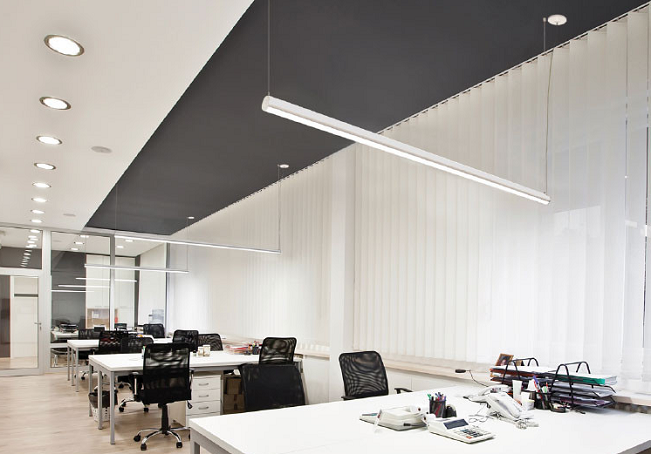
What Are the Main Types of Office Lighting?
Office lighting primarily falls into three categories: ambient lighting, task lighting, accent lighting, and decorative Lighting.
- Ambient Lighting Ambient lighting acts as the base layer of illumination in a room. It’s typically generated by large, strategically placed fixtures that emit light with a certain color, temperature, intensity, and Color Rendering Index (CRI) to ensure optimal visibility. The primary goal of ambient light is to illuminate an entire space without causing eye strain, making it a crucial component of any office environment. This is typically achieved via overhead fixtures.
- Task Lighting Task lighting, as its name implies, is designed to aid in specific tasks that require more light than what ambient lighting provides, like desks or conference tables. For instance, in an office where employees frequently engage in paperwork, task lighting installed over desks can enhance readability and overall productivity and helps prevent eye strain.
- Accent Lighting Accent lighting is used to highlight specific areas or objects within an office, drawing attention and focus. For example, accent lights can be used to illuminate notice boards, making them more noticeable to employees and thus enhancing communication.
- Decorative Lighting Decorative lighting’s role goes beyond mere illumination; it’s about adding aesthetic appeal and creating a vibrant, engaging atmosphere. Such lighting can be used to make a workspace more inviting and can also create a distinct ambiance in areas like canteens, offering employees a refreshing change from the regular work environment during their break times.
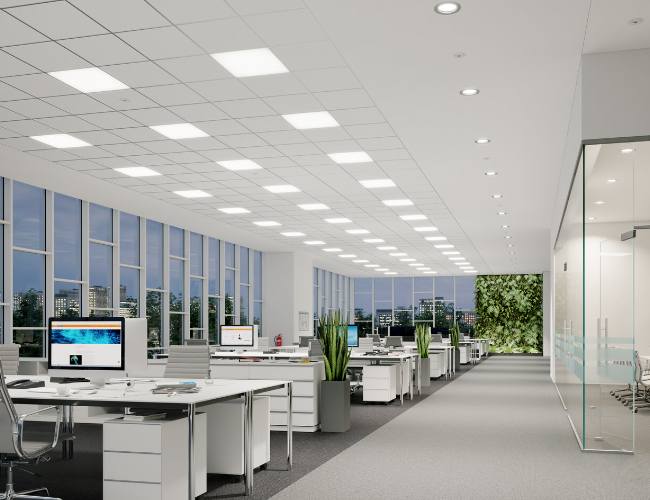
What Types of LED Lights Could Be Used in Office?
When it comes to LED lighting for offices, there are several types that are commonly used, each with its own benefits and ideal applications.
- LED Panels: LED panels are typically used for general office lighting due to their uniform light distribution, high efficiency, and sleek, modern design. They can replace traditional fluorescent troffers to provide a more energy-efficient and long-lasting lighting solution. These are often used in drop ceilings or can be suspended or mounted directly on the ceiling.
- LED Downlights: Also known as pot lights or recessed lights, LED downlights are often used in offices for their sleek, unobtrusive design and directional lighting. They’re excellent for task lighting or accent lighting.
- LED Desk Lamps: For task lighting, especially in areas that require focused illumination like workstations, LED desk lamps are an excellent choice. Many LED desk lamps come with adjustable brightness and color temperature controls.
- LED Strip Lights: LED strip lights are flexible and versatile. They can be used for decorative purposes, to create ambiance, or to provide indirect lighting in an office.
- LED Track Lights: LED track lighting is a versatile option that can provide both ambient and task lighting. The individual lights on the track can be directed to specific areas, making them ideal for highlighting artwork, architectural details, or workspace areas.
- LED Tubes: LED tubes are used to replace traditional fluorescent tube lights. They provide a much more energy-efficient and long-lasting solution with better light quality.
- LED Pendant Lights: These hanging lights can provide both ambient and task lighting, and can add a touch of style to office spaces. They’re often used in reception areas, over conference tables, or in break rooms.
- LED Wall Sconces: Wall sconces can provide indirect ambient lighting, and can also contribute to the overall design aesthetic of the office.
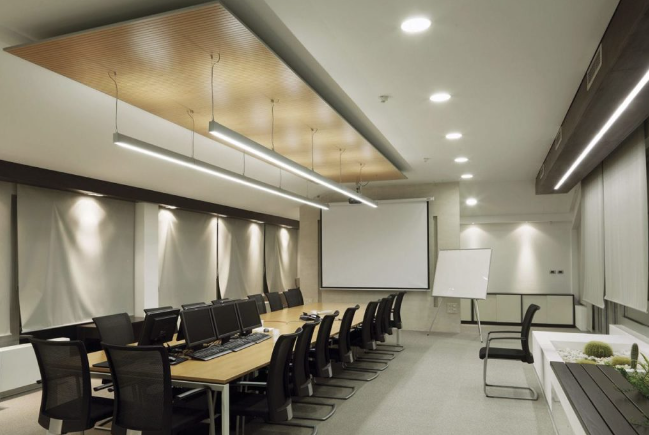
Remember, the choice of office lighting should not only reflect the needs of the space in terms of illumination but also complement the aesthetics and functionality of the office. Mixing and matching different types of lights can create layers of light that help meet different needs throughout the day and across various tasks.
Factors To Consider When Choosing Office Lighting
Now that you are familiar with the importance of the right office lighting and the main types of lighting, let’s look at some factors that must be considered in the process. Understanding these factors will help you create a balanced, productive environment that caters to your team’s needs.
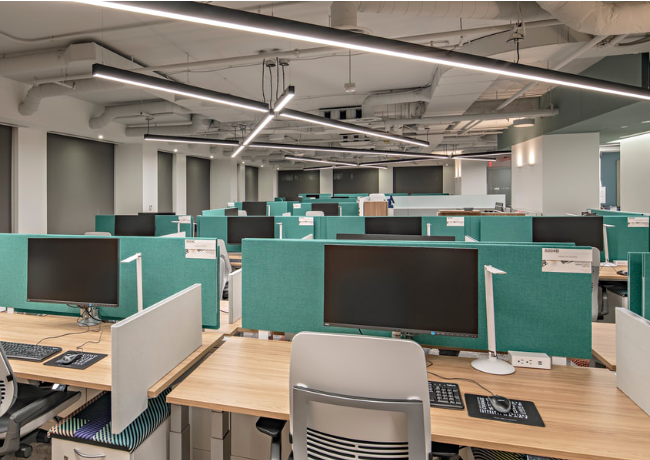
- Choice of Lights There are numerous lighting solutions available today, including Halogen Bulbs, Incandescent Bulbs, and LEDs. However, LEDs are the go-to choice for modern offices. Why? Because they are energy-efficient, reducing power consumption by up to 80% compared to traditional light bulbs. Additionally, their versatility in size and shape means they can fit into any office design you envisage.
- Light Intensity The intensity or brightness of light is a critical factor in ensuring a space’s usability. You don’t want your office to be overly bright, causing discomfort, or too dim, hampering visibility. Light intensity is measured in lumens, and for most offices, the Illuminating Engineering Society (IES) recommends approximately 30 to 50 foot-candles or 300 to 500 lumens per square foot for typical office tasks. This range will ensure that your office is sufficiently lit for most tasks without causing undue eye strain or discomfort.
- Color Temperature The color temperature of light, measured on the Kelvin Scale, signifies the color a light source emits. It ranges between 1,000 to 10,000K. Lights under 4000K emit a warm, yellowish glow, while those above 4000K produce a cool, white light. This choice affects not just aesthetics but also employees’ mood and productivity. Research suggests that cooler lights (above 4000K) can enhance alertness and reduce fatigue, making them a better choice for office spaces.
- Color Rendering Index (CRI) CRI is an essential parameter that shows how accurately a light source can reproduce the colors of objects, akin to natural light. The scale ranges from 1 to 100, with 100 being the closest to natural light. While high CRI is generally desirable, certain design elements might benefit from lower CRI, adding a creative touch to your office lighting plan. The ideal Color Rendering Index (CRI) for office lighting is typically 80 or above. This level of CRI allows for accurate color representation, which is especially important in an office setting where detailed tasks requiring accurate color discernment are performed. Higher CRI lighting can also enhance the overall aesthetics of a space, creating a more pleasant and visually accurate environment. However, it’s worth noting that the specific CRI required can depend on the nature of the work being done in the office. For example, design or art studios might need lighting with a CRI closer to 100 for the most accurate color rendering.
- Glare Reduction Prolonged exposure to glare can lead to eye strain and related health issues, affecting productivity. It’s particularly important to manage glare when employees spend a lot of time working on screens. By optimizing ambient light around workstations, you can minimize screen glare. Additionally, investing in anti-glare fixtures can further enhance comfort and productivity.
- Energy Efficiency With numerous lights required to adequately illuminate an office, energy consumption becomes a significant consideration. Using energy-efficient LEDs can dramatically reduce your overhead. LEDs, despite their slightly higher upfront cost, can lead to substantial savings in the long term, reducing energy bills by up to 75%.
In conclusion, investing in good office lighting is not just beneficial but necessary. It contributes to the productivity, health, and overall satisfaction of employees, leading to a more successful and efficient work environment.
What Are The Tips for Designing Office Lighting?
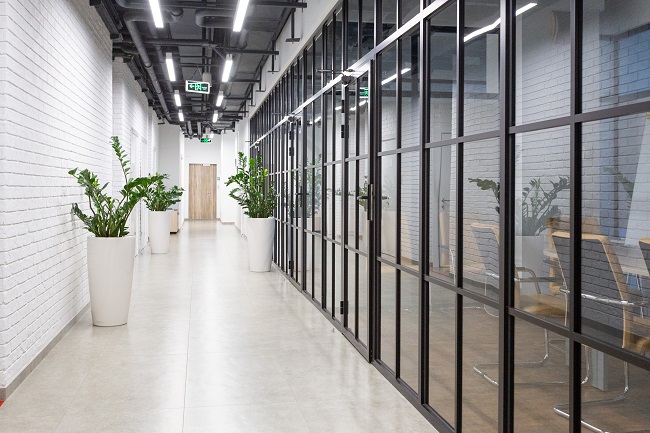
Designing office lighting requires a thoughtful approach to creating a space that supports productivity, comfort, and the overall well-being of employees. Here are some professional tips for designing office lighting:
- Consider Task Needs: Different tasks require different lighting levels. For example, intensive computer work or reading requires brighter, more focused light, whereas a meeting area may benefit from softer, more diffused lighting.
- Embrace Natural Light: Where possible, maximize the use of natural light. It’s beneficial for the well-being of employees and can help reduce energy costs. Just be mindful of how to control it to prevent glare, which can cause discomfort and reduce visibility on screens.
- Use Layers of Light: A combination of ambient, task, accent, and decorative lighting can cater to different needs and create a more dynamic and versatile space. This layered approach can accommodate various tasks and moods.
- Choose the Right Color Temperature: Light temperature can influence mood and productivity. Cooler light (higher Kelvin numbers) promotes alertness and is generally better for concentration and task-oriented work, while warmer light (lower Kelvin numbers) creates a relaxed and inviting atmosphere.
- Mind the Color Rendering Index (CRI): Choose lighting with a high CRI (80 and above) for areas where color accuracy is crucial. High CRI lighting can make the environment look more vibrant and real, improving the aesthetics of the workspace.
- Reduce Glare: Overly bright lights can cause glare, leading to eye strain and discomfort. Use fixtures that direct light downward and consider diffusers to reduce glare, especially in areas with computer screens.
- Think of Energy Efficiency: Consider energy-efficient light sources like LEDs. They consume less energy and have a longer lifespan, reducing both your carbon footprint and energy costs.
- Light Control: Implementing dimmers, motion sensors, or smart lighting systems can provide flexibility, allowing customization based on personal preference, time of day, or type of task being performed.
- Consider Professional Help: Depending on the size and complexity of your office, it might be beneficial to engage a lighting designer. They can provide expert advice and solutions, ensuring your office is lit appropriately and comfortably.
Remember, the goal of office lighting design is to create a comfortable, productive environment that supports the well-being of the people using the space.
F.A.Q.:
In conclusion, the importance of optimal office lighting can’t be overstated. It greatly influences mood, productivity, and overall health of your employees. From the types of lighting—ambient, task, accent, and decorative—to the specific characteristics of the lights, such as intensity, color temperature, and Color Rendering Index (CRI), each aspect plays a unique role in shaping your office environment. Factors such as glare reduction and energy efficiency are also essential for a comfortable and sustainable workspace. With the right approach, good lighting design can transform your office into a vibrant, efficient, and enjoyable place to work. Remember, investing in proper office lighting is not an expense, but an investment in your team’s productivity and well-being.
